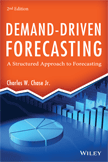Supply Chain Lead Times
Most companies with a supply chain have to deal with supply lead times. When I worked in the processed meats industry many years ago, production plans were locked three weeks in advance.That's how long it took to secure raw materials and schedule the production lines.
Many companies deal with much longer supply lead times, for example, over 12 months for some products at an aviation parts supplier I corresponded with this week.
The usual (and correct) practice is to measure forecasting performance based on the forecast as it stood at the lead time. This is only fair -- to measure accuracy at the time a decision (the supply plan) has to be made. It would be cheating to report your accuracy within the lead time, since that forecast could not have been used to effect any changes in the locked supply plan.
Supply plans within the lead time are "frozen" and can't be changed. (That's kind of why it's called the lead time.) But should the forecast within lead time be frozen as well? There are actually good reasons to continue updating a forecast for a period even when it is too late to impact the supply in that period.
Reasons to Update Forecasts Within Lead Time
You can impact supply plans for future periods
It is now January 2018, and suppose I need to lock my forecast for March. I finalize and submit my forecast, and the March supply plan is created and frozen. But then in February, we learn about a huge new customer order for March, that will consume nearly all of the inventory we currently have planned. Since February is within the lead time, there is nothing we can do to change the March supply, so what is the point of updating the March forecast?
The point is that with an updated March forecast, our systems will project that inventory will be wiped out. Therefore, we'll need to increase supply as soon as possible. Since we find this out in February, we can increase April supply plans to bring inventory back to appropriate levels. So we are reacting as fast as possible to the new demand information.
If we did not update the March forecast in February, our planning systems might not be aware that inventory was going to be wiped out until it actually happened. And once the inventory is wiped out in March, our next chance for recovery isn't until May -- because it is too late to adjust April plans.
More accurate revenue projections
Another good outcome of adjusting the forecast within lead time is that financial projections should become more accurate. It would be helpful to know, in February, that the March revenue is going to be higher than originally projected. (This is probably even more important when there is a major downward adjustment of the forecast within lead time, and there will be a revenue shortfall.)
While it would be silly to make small forecast adjustments within lead time (just as it is silly to ever make small adjustments to forecasts), meaningful / impactful adjustments should be made. Within lead time forecast adjustments help you react in a more timely manner to expected demand shifts -- rather than just being blindsided when they occur.
You can determine whether forecast accuracy improves as you get closer to the period being forecast
It is also interesting to find out how much improvement there is in the forecast as you get closer to the period being forecast. Presumably, there will be improvement, as you are taking advantage of more history and information.
 If you find the forecast significantly improves within supply lead time, this might motivate a re-engineering of your production / supply processes, to reduce lead times.
If you find the forecast significantly improves within supply lead time, this might motivate a re-engineering of your production / supply processes, to reduce lead times.
And if you find the forecast actually gets less accurate within lead time, this suggests you have a really messed up organization. The most common reason I've seen for this issue is when organizations roll their misses into future periods, to maintain a quarterly or annual number.
My colleague Charlie Chase has called this the "hold-and-roll," and has an amusing discussion of this on pages 22-25 of his book, Demand-Driven Forecasting (2nd edition). You can download an excerpt at the link.
